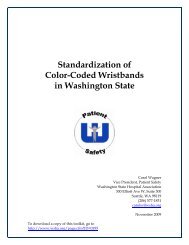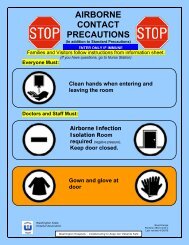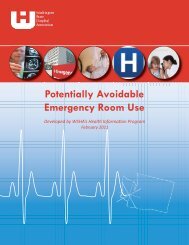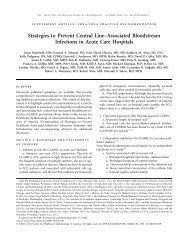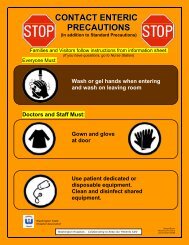Standardization of Color-Coded Wristbands in Washington State
Standardization of Color-Coded Wristbands in Washington State
Standardization of Color-Coded Wristbands in Washington State
Create successful ePaper yourself
Turn your PDF publications into a flip-book with our unique Google optimized e-Paper software.
Wash<strong>in</strong>gton <strong>State</strong> Hospital Association<strong>Standardization</strong> <strong>of</strong> <strong>Color</strong>-<strong>Coded</strong><strong>Wristbands</strong> <strong>in</strong> Wash<strong>in</strong>gtonImplementation ToolkitDo Not ResuscitateAllergy AlertFall RiskWash<strong>in</strong>gton <strong>State</strong> Hospital AssociationAddress: 300 Elliott Avenue West, Suite 300 • Seattle, WA 98119Phone: (206) 577-1831 B<strong>in</strong>der Website: http://www.wsha.org/page.cfm?ID=0195June 2008Wash<strong>in</strong>gton <strong>State</strong> Hospital Association (WSHA) produced these materials based on documents from the ArizonaHospital and Healthcare Association and other hospital associations.“Zero errors that affect patient’s health”
<strong>Standardization</strong> <strong>of</strong><strong>Color</strong>-<strong>Coded</strong> <strong>Wristbands</strong><strong>in</strong> Wash<strong>in</strong>gton <strong>State</strong>To download a copy <strong>of</strong> this toolkit, go tohttp://www.wsha.org/page.cfm?ID=0195Carol WagnerVice President, Patient SafetyWash<strong>in</strong>gton <strong>State</strong> Hospital Association300 Elliott Ave W, Suite 300Seattle, WA 98119(206) 577-1831carolw@wsha.orgJune 2008
Wash<strong>in</strong>gton <strong>State</strong> Hospital Association<strong>Color</strong>-<strong>Coded</strong> <strong>Wristbands</strong>Executive SummaryOverviewWash<strong>in</strong>gton hospitals provide very good care for patients. Yet, we know moreneeds to be done to make care safer. Across the nation, hospitals are look<strong>in</strong>g forways that they can reduce the risk <strong>of</strong> harm to patients. In review<strong>in</strong>g adverseevent data from across the nation, it was identified that some errors have comefrom the variation <strong>in</strong> the use <strong>of</strong> color-coded wristbands by hospitals. InDecember 2005, a patient safety advisory was issued that brought to light an<strong>in</strong>cident that occurred <strong>in</strong> a hospital <strong>in</strong> which cl<strong>in</strong>icians nearly failed to rescue apatient whose heart stopped because the patient was <strong>in</strong>correctly designated asDo Not Resuscitate or “DNR.”The source <strong>of</strong> confusion was the different practices between hospitals on colorcodedwristbands. A nurse placed a yellow wristband on a patient. In thathospital, a yellow wristband meant DNR. In the nearby hospital, where thenurse also worked, yellow meant “restricted extremity” which was what she wastry<strong>in</strong>g to communicate to other staff. Fortunately, another nurse recognized themistake and the patient was resuscitated.As a result, there is a national effort underway to standardize the colors andword<strong>in</strong>g on wristbands.A color-coded wristband is a means to convey or communicateimportant medical <strong>in</strong>formation or an alert about the status <strong>of</strong> a patient.This b<strong>in</strong>der is based on the national agreement <strong>of</strong> the colors that should be usedby hospitals if they use color-coded wristbands. The Wash<strong>in</strong>gton <strong>State</strong> HospitalAssociation is support<strong>in</strong>g this effort at the request <strong>of</strong> members who are look<strong>in</strong>gfor ways to reduce harm to patients. They believe this process is importantbecause many <strong>of</strong> our staff and physicians work <strong>in</strong> multiple hospitals.“Zero errors that affect patient’s health” 1
As part <strong>of</strong> this process, the Wash<strong>in</strong>gton <strong>State</strong> Hospital Association conducted asurvey to measure the variation <strong>in</strong> use <strong>of</strong> color-coded wristbands <strong>in</strong> Wash<strong>in</strong>gtonhospitals.Follow<strong>in</strong>g are the survey results for Wash<strong>in</strong>gton –Types <strong>of</strong> <strong>Wristbands</strong> <strong>Color</strong> Percent <strong>of</strong> Wash<strong>in</strong>gtonHospitals Already Us<strong>in</strong>gDo Not Resuscitate (DNR) Purple 50%Allergy Alert Red 76%Fall Risk Yellow 78%These are the same colors which have been agreed to nationally andimplemented <strong>in</strong> Arizona, California, <strong>Color</strong>ado, Nevada, New Mexico, Oregon,Utah, and now the state <strong>of</strong> Wash<strong>in</strong>gton. The wristbands look like:Do Not ResuscitateAllergy AlertFall RiskThe <strong>in</strong>formation presented <strong>in</strong> this b<strong>in</strong>der is not meant to encourage the use <strong>of</strong>color-coded wristbands, but to <strong>in</strong>crease safety <strong>in</strong> those hospitals that use them.2“Zero errors that affect patient’s health”
Results <strong>of</strong> <strong>Color</strong>-<strong>Coded</strong> <strong>Wristbands</strong> Survey <strong>in</strong>Wash<strong>in</strong>gton HospitalsAllergyPercentage <strong>of</strong> TimeHospitals Use This <strong>Color</strong>Red 76%Yellow 7%Orange 3%Clear 3%Green 3%Purple 3%Red & White 3%AllergyFall Risk Percentage <strong>of</strong> TimeHospitals Use This <strong>Color</strong>Yellow 78%Green 11%Purple 11%Fall RiskDNRPercentage <strong>of</strong> TimeHospitals Use This <strong>Color</strong>Red 8%Yellow 8%Green 17%Purple 50%P<strong>in</strong>k 8%Blue 8%Do Not Resuscitate“Zero errors that affect patient’s health” 3



